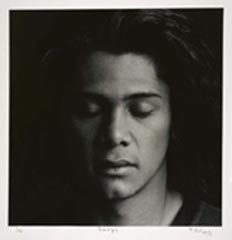
22 February - 27 April 2008
Art Gallery of New South Wales  
I want to get away from the ethnographic image of Aboriginal people in magazines.
…I want to…show young Aboriginal people in the cities today; a lot of them [are] very sophisticated and [a] lot of them very glamorous. A lot of them have been around the world and have an air of sophistication which you don’t see coming across in newspapers and [television] programs. I’m just talking about positive things really, positive images of Aboriginal people. - Michael Riley, 1993 Michael Riley (1960-2004) was one of the most important contemporary Indigenous visual artists of the past two decades and his contribution to the urban-based Indigenous visual arts industry was substantial. His emotive film and video work challenged non-Indigenous perceptions of Indigenous experience, particularly of the most disenfranchised communities in the south-eastern region of Australia. Michael Riley: sights unseen reveals the prolific talents of a quiet observer whose photomedia, video and film continues to have a profound effect on Australia’s contemporary representation and comprehension of Indigenous Australia. This landmark exhibition is the first major survey of Michael Riley’s work. Brenda L Croft, Senior Curator of Aboriginal and Torres Strait Islander Art at the National Gallery of Australia has worked closely with Riley’s family, friends and colleagues to draw together a comprehensive body of work, charting the vision and experience of one of the country’s most significant visual artists, chronicling a period of intense cultural development and achievement. Riley brought a singularly Indigenous visual language to the forefront of international contemporary art, as was highlighted by his selection for and high profile in the 2003 Istanbul Biennial: Poetic justice. Riley’s work draws on a multiplicity of influences: European and western (particularly British and North American) Indigenous and non-Indigenous film-making; international fashion and design; and Indigenous and European spirituality and its contradictions. His portraits of family and community were the antithesis of the bleak photojournalist studies of contemporary Aboriginal life in towns and cities so often portrayed in print media of the day, with the obvious warmth between subject and photographer evident in the photographs. Throughout all Riley’s work is a sense of exploration of media to represent the diverse aspects of contemporary Aboriginal life in the south-east accurately. His first conceptual body of work was the languidly beautiful series of 15 gelatin silver images comprising Sacrifice 1993. It is in this series that the symbol of the cross – that most potent of Christian icons – first appeared, looming large against a turbulent sky. Christianity is a subject to which Riley returned again in later work, such as in the flyblown series of 1998 and the commissioned short film Empire in 1997. Riley’s images reflect what he has described as the ‘sacrifices Aboriginal people made to be Christian’. They resonate with loss – experienced not only by the individual, but by entire Indigenous communities – ‘loss’ of culture and land in an enforced and sometimes embraced ‘exchange’ for Christianity. Considered one of Australia’s most important contemporary artists, many of his films won awards at national and international festivals. Riley’s work is represented in various major public and private collections throughout Australia. In early 1998 a debilitating illness impacted on the artist’s professional and personal life. Riley’s last and most significant body of work, cloud 2001, shifted from terra firma to otherworldly locations' concerns. Michael Riley: sights unseen will not only profile Riley’s most recognised photomedia, films and video work, but will also present some images previously unseen in the public domain. It will be accompanied by a monograph, illustrated in full colour, with text by renowned Indigenous and non-Indigenous Australian contributors. Michael Riley: sights unseen is a National Gallery of Australia Travelling Exhibition, proudly supported by the National Gallery of Australia Council Exhibitions Fund. Additional support has been provided by the Michael Riley Foundation and Visions of Australia, an Australian Government Program supporting touring exhibitions by providing funding assistance for the development and touring of cultural material across Australia. This project has also been assisted by the Australian Government through the Australia Council, its arts funding and advisory body, Boomalli Aboriginal Artists Co-operative and Australian Air Express.
|